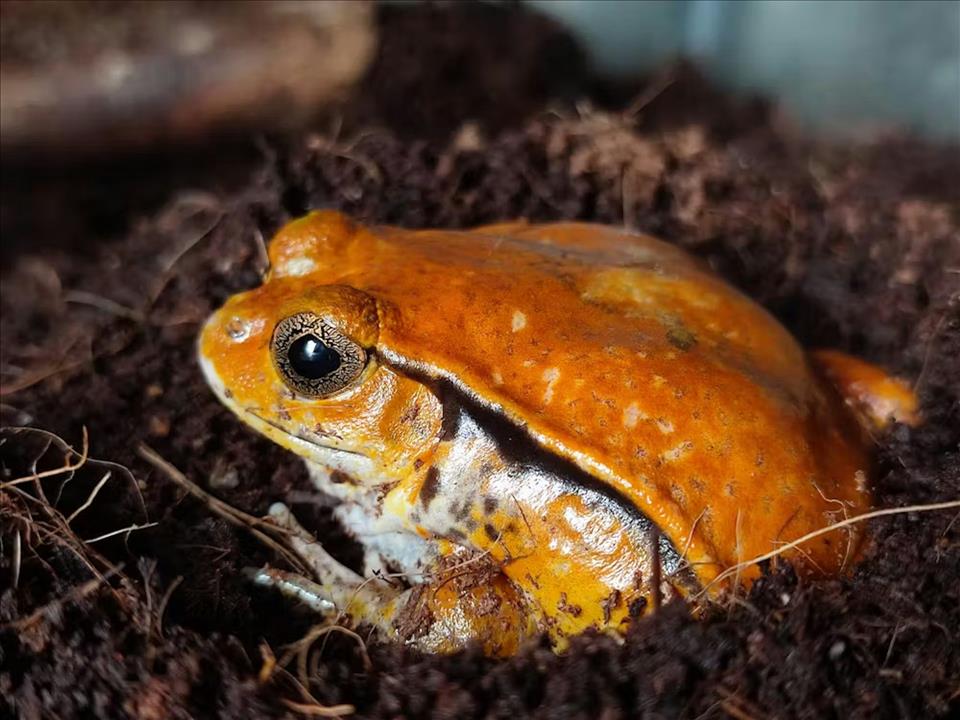
Glue In The Face: How Frogs' Sticky Secretions Defend Them From Attack
The Frog Prince. Author provided (no reuse)
In reality, many frog species produce poison in their skin, the effects of which can range from mild nausea to death, so this display of affection is generally ill-advised. But what if the frog had found a more unusual way to defend itself, one that left our heroine's lips sealed by the kiss instead?
Biological adhesives: a tale as old as slimeWhile humans mainly use synthetic materials to make things sticky, our princely frog – like other glue-producing organisms – produces what is known as a“biological adhesive”. These naturally secreted materials are widespread among animals, and are often essential for their survival.
For example, mussels and barnacles produce a type of glue that permanently cements them to the underwater surfaces they call home, while other ocean-dwelling animals, such as starfish, use a different, much more temporary kind of glue to help them move around.
Back on land, the most famous example is spider glue , commonly used to create silk for prey capture. However, our focus here is on terrestrial vertebrates, the stickiest specimens being the feet of geckos and certain tree frogs. These are examples of“dry” and“wet” adhesion, meaning that geckos stick to surfaces without actually producing anything that resembles glue , while the toe pads of tree frogs are covered with a thin layer of slime, or mucus .
Read more: Glues inspired by nature will give us faster ships, surgical adhesives and sticky car tyres
Despite their obvious dissimilarities, both of these types of adhesion have been described as“self-cleaning”, and may help us to develop synthetic materials that share this trait. Indeed, the ways that different biological adhesives are formulated and then secreted often involve wondrous feats of natural engineering .
In other cases, however, glue secretion has less to do with complex geometrical operations, and more to do with discharging copious amounts of slime all at once.
Sticky secretions: an unlikely defence mechanismFrom traditional medicine and shamanistic rituals to folk tales and myths, frogs and toads are culturally significant across the world. The frog's poison glands are especially prominent, as they can be used to make weapons , treatments , or even hallucinogens .
Read more: Illegal, occasionally deadly, and not much fun. What is the frog toxin Kambô and why do people use it?
To date, studies on amphibian skin-secreted defences have focused on molecules that function as toxins. However, aside from being purveyors of poison, a small number of species (including the world's largest amphibian, the Chinese giant salamander ) have come up with a more obscure (and much stickier) survival strategy: glue.
Meet the tomato frog.
Dyscophus guineti: round, orange, and endemic to Madagascar. Shabnam Zaman/VUB, Author provided (no reuse)
When stressed, the animal's skin releases a thick fluid that becomes extremely sticky within seconds. From a frog's perspective, this stress usually takes the form of an attack by a predator (or princess). The speed with which the viscous secretion – a sticky slime, basically – turns into a glue makes it nearly impossible for a predator to ingest the frog, likely due to the annoyance caused by having its mouth and face coated with glue.
While this tactic may sound crude and inelegant, it is an effective defense mechanism, as it gives the frog time to escape.
Retracing an evolutionary slime trailAlthough glue is a rare feature in frogs, it has evolved several times in species that are spread across different continents. My recently published research explores the origins of this remarkable survival strategy, and why it is present in some frogs but not in others.
To answer these questions, we first needed to identify the ingredients responsible for creating frog glue's stickiness. We did this using technologies ranging from low-tech Lego bricks to high-tech microscopes that can magnify on a nanoscale (a billionth of a meter).
Small, but fiercely sticky. Frederik Van Den Eeckhaut/VUB, Author provided (no reuse)
Surprisingly, what we found is that the base ingredients needed to make this glue exist in almost all animals, including humans, but only amphibians have evolved the necessary toolkit for turning them into glue. And, even within amphibians, only a select few species – ones that live as far apart as Madagascar, Brazil and Australia – have actually gone on to develop this ability.
In fact, we found that the Mozambique rain frog, which is separated from the tomato frog by about 100 million years of evolution, uses the same base ingredients and toolkit to create its own adhesive secretion. Perhaps the most infamous use of this glue actually involves sticking male frogs to females, as Sir David Attenborough himself has attested .
From biology to biomimicry: a seriously sticky surgical solutionWhile frog glue is fascinating, it is also extremely fast-acting and flexible, meaning it has huge potential for practical applications. This is where biomimetics comes in: a field that strives to mimic biological processes that nature has evolved over millions of years.
Thanks to our research we now know, for the first time, exactly how glue is produced by a four-legged animal. Imagine how medical adhesives inspired by frog glue can be used as surgical sealants: not only is it strong and nontoxic, but it's capable of adapting and sticking to practically any surface.
So the next time you stumble across an unsuspecting frog, be gentle – remember, it might just hold the key to one day healing your heart.

Legal Disclaimer:
MENAFN provides the
information “as is” without warranty of any kind. We do not accept
any responsibility or liability for the accuracy, content, images,
videos, licenses, completeness, legality, or reliability of the information
contained in this article. If you have any complaints or copyright
issues related to this article, kindly contact the provider above.
















Comments
No comment